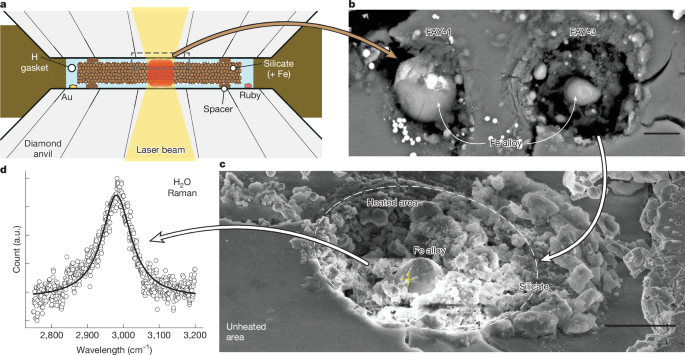Building wet planets through high-pressure magma–hydrogen reactions
Summary
New high-pressure experiments show dense hydrogen reacting directly with molten silicates to free oxygen and produce large quantities of water (H2O) inside planets. Using pulsed laser-heated diamond-anvil cell experiments at pressures up to tens of gigapascals and temperatures of several thousand kelvin, the team observed reduction of Si from silicates to form Fe–Si alloys and formation of hydrides (FeHx, SiH4). The liberated oxygen reacts with hydrogen to yield water — sometimes amounting to tens of weight per cent — far more than earlier low-pressure models predicted. These reactions can operate at core–envelope boundaries (CEBs) of sub-Neptune-sized planets and may convert hydrogen-rich envelopes into water-rich interiors from the inside out, decoupling atmospheric water detection from simple formation-location inferences.
Key Points
- Direct hydrogen–magma reactions at high P–T reduce Si and Fe in silicates, producing Fe–Si alloys and hydrides while releasing oxygen that forms H2O.
- Experiments produced water fractions up to a few tens of weight per cent — orders of magnitude higher than prior low-pressure extrapolations predicted.
- SiH4 and FeHx are produced alongside H2O; hydride formation and miscibility of H2/H2O/SiH4 influence transport and envelope composition.
- Conditions at core–envelope boundaries of 3–10 Earth-mass planets with a few wt% H2 match experimental P–T, so endogenic water production is plausible for many sub-Neptunes.
- Convective mixing, ingassing and planetary redox state control how much water accumulates in the envelope vs the deep interior and how long production persists.
- Implication: detection of atmospheric water does not necessarily imply formation beyond the snow line — water-rich close-in planets can form in situ by internal chemistry.
Content summary
The authors used pulsed laser heating in a hydrogen atmosphere inside diamond-anvil cells to melt silicate + metal samples at pressures up to ~42 GPa and temperatures above 2,500–4,000 K. X-ray diffraction and Raman spectroscopy show silicates break down: Si is partially reduced and alloyed with Fe, Mg largely remains as MgO, and hydride species (FeHx, SiH4) appear. The oxygen released from silicates readily reacts with hydrogen to make H2O; measured water production in experiments reached ~18 wt% in representative runs and theoretical bounds indicate potential water mole fractions of ~0.38–0.56 under some conditions. The paper couples these experimental results to interior evolution models for sub-Neptunes, showing that core temperatures and convective mixing can sustain reactions for long timescales and distribute water within the envelope. The authors discuss how varying bulk composition (Mg:Si ratios), envelope mass fraction, and atmospheric loss histories modulate final water inventories and the possibility of producing secondary oceans or hydrospheres after gas loss.
Context and relevance
This study challenges a central assumption in exoplanet interpretation: that abundant water signatures require formation beyond the snow line and subsequent migration. The experiments demonstrate an in-situ pathway for turning primordial H2 envelopes into H2O-rich layers via high-pressure reactions with molten rock. That has broad consequences: it affects how we interpret radius–mass data, JWST and other atmospheric detections of water, the origin of the radius valley, and the prevalence of “hycean” or water-rich worlds among 3–10 Earth-mass planets. The work links high-pressure geochemistry, lab techniques and planetary evolution models to show a physically plausible route for producing wet planets from initially dry materials plus a hydrogen envelope.
Author style
Punchy: this is a big one. The experiments provide tangible lab evidence that hydrogen can chemically convert rock into water at interior conditions relevant to sub-Neptunes — changing how we link composition to formation. If you follow exoplanet atmospheres, planet formation or planetary interiors, the details matter: the amounts, the hydride species and the mixing physics will affect observations and models.
Why should I read this?
Because it smashes a neat shortcut: seeing lots of water in a planet’s atmosphere doesn’t automatically mean it migrated in from icy regions. The paper gives real lab data showing hydrogen + magma can make big amounts of water inside planets — and that could rewrite how we read exoplanet atmospheres. Quick, surprising and directly relevant if you care about how planets end up wet.

